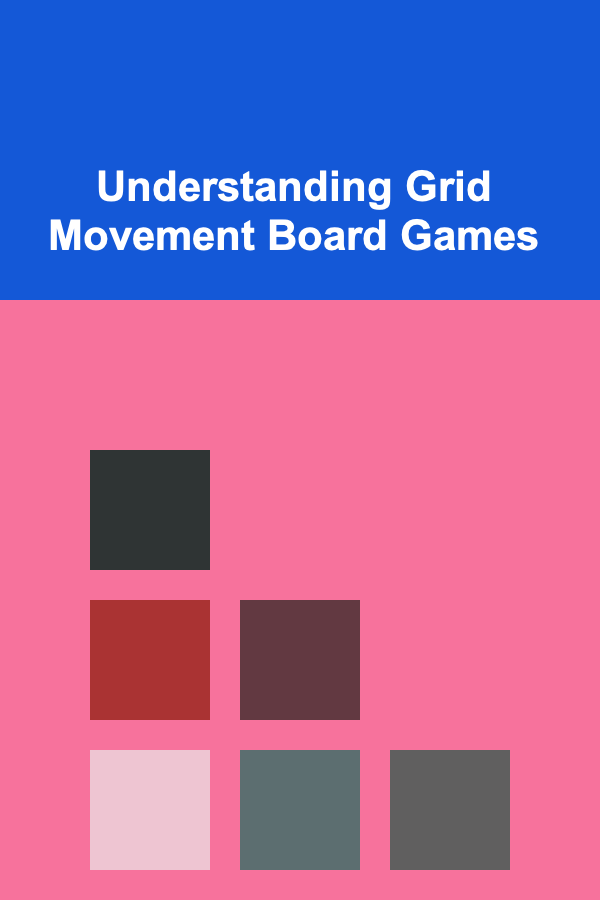
Understanding Grid Movement Board Games
ebook include PDF & Audio bundle (Micro Guide)
$12.99$6.99
Limited Time Offer! Order within the next:

Grid movement board games represent a vast and diverse category within the tabletop gaming hobby. From abstract strategy to immersive thematic experiences, the use of a grid to regulate movement provides a foundation for intricate tactical decisions and strategic planning. This article delves into the nuances of grid movement board games, exploring the different types of grids, movement mechanics, strategic considerations, and the factors that contribute to their enduring popularity. We will examine various games, both classic and modern, to illustrate these concepts and provide a comprehensive understanding of this captivating genre.
The Foundation: Grids and Their Characteristics
The grid is the fundamental element that defines this type of game. It dictates how players navigate the game world, representing terrain, distance, and tactical positioning. While seemingly simple, the type of grid used dramatically impacts the gameplay experience.
Square Grids
The most common type of grid is the square grid. This familiar structure, comprised of squares arranged in rows and columns, offers simplicity and intuitive movement. Each square typically represents a single unit of distance, and movement options are usually limited to orthogonal directions (up, down, left, right). Diagonal movement may also be allowed, sometimes at an increased cost.
The ubiquity of square grids stems from their ease of understanding and implementation. Counting movement points is straightforward, and visualizing paths is relatively simple. This makes square grids ideal for games that emphasize tactical combat, resource management, and direct control of units.
Examples of games utilizing square grids include:
- Chess: While not explicitly stated, chess can be conceptualized as taking place on an 8x8 square grid, where each piece's movement is dictated by the grid structure.
- Checkers (Draughts): Another classic, with movement restricted to diagonal squares.
- Ticket to Ride: Although not directly moving pieces on a grid, the board itself is a network with clearly defined routes that are equivalent to grid movement.
- War of the Ring: Uses area movement primarily, but includes grid-based battles within the Shire.
Hexagonal Grids
Hexagonal grids, composed of hexagons arranged adjacently, offer a distinct alternative to square grids. One key advantage of hexagonal grids is that all six adjacent spaces are equidistant from the central space. This eliminates the diagonal movement problem inherent in square grids, where diagonal movement is often treated differently from orthogonal movement.
Hexagonal grids tend to foster a more natural and fluid sense of movement. Units can maneuver in multiple directions with equal ease, which can lead to more dynamic and strategic positioning. Hex grids are frequently used in wargames, where realistic movement and line-of-sight considerations are crucial.
Examples of games utilizing hexagonal grids include:
- Settlers of Catan: The resource-generating tiles are arranged in a hexagonal pattern.
- Twilight Imperium: Space sectors are represented by hexagonal tiles.
- Memoir '44: A historical wargame that often uses hexagonal spaces for movement and combat.
- Terraforming Mars: Hexagonal tiles are placed on the planet to develop areas.
Isometric Grids
Isometric grids present a three-dimensional perspective on a two-dimensional surface. While they technically utilize a square grid structure, the visual representation creates a sense of depth and can enhance the game's aesthetic appeal.
Movement on isometric grids typically follows the same rules as square grids, but the visual presentation can sometimes introduce challenges in accurately judging distances and line-of-sight. Games using isometric grids often feature terrain elevation and obstacles that further complicate movement planning.
Examples of games utilizing isometric grids are less common but can include:
- Certain video game conversions to board games where the original game had an isometric perspective.
Other Grid Variations
Beyond the standard square, hexagonal, and isometric grids, there are other variations that games employ to achieve specific design goals.
- Irregular Grids: Some games utilize grids with irregularly shaped spaces or varying sizes. These grids can represent natural terrain features or abstract strategic zones.
- Overlapping Grids: Games may feature multiple grids overlaid on top of each other, representing different layers of information or strategic zones.
The choice of grid type is a crucial design decision that significantly influences the gameplay experience. Square grids offer simplicity and directness, hexagonal grids promote fluid movement and realistic representation, and isometric grids add visual depth. The other variations are more specialized and are usually seen in specific types of games.
Movement Mechanics: Navigating the Grid
The movement mechanics dictate how pieces travel across the grid. These rules determine the options available to players and the constraints they must consider. They significantly impact the strategic depth and tactical considerations of the game.
Basic Movement Points
The most common movement mechanic involves allocating a certain number of movement points to each unit or character. Each space moved typically costs one movement point, but this can vary depending on terrain, obstacles, or special abilities. Players must carefully plan their movement to maximize their effectiveness while staying within their movement point budget.
This simple mechanic allows for a wide range of strategic possibilities. Players must consider the most efficient routes, anticipate enemy movements, and balance their desire to cover ground with the need to conserve movement points for other actions.
Variable Movement
Some games introduce variable movement, where the number of movement points a unit has can fluctuate based on various factors. These factors might include:
- Terrain: Moving through difficult terrain might cost additional movement points.
- Weather: Weather conditions can impede movement, reducing the number of available movement points.
- Damage: Injured units may have reduced movement capabilities.
- Abilities: Special abilities or upgrades can increase movement points or allow units to ignore terrain penalties.
Variable movement adds a layer of complexity to the game, forcing players to adapt to changing circumstances and make difficult decisions about how to allocate their resources.
Special Movement Abilities
Many games feature units or characters with special movement abilities that deviate from the standard movement rules. These abilities can include:
- Teleportation: The ability to instantly move from one location to another.
- Flight: The ability to move over obstacles and difficult terrain without penalty.
- Tunneling: The ability to move under obstacles or through restricted areas.
- Leaping: The ability to jump over spaces or obstacles.
These special movement abilities can dramatically alter the strategic landscape of the game, creating opportunities for surprising attacks, flanking maneuvers, and rapid repositioning.
Zone of Control
Zone of control (ZOC) is a common mechanic, particularly in wargames, where a unit exerts influence over adjacent spaces, restricting enemy movement. Entering or leaving a space within a unit's ZOC may require additional movement points or be completely prohibited. This makes strategic positioning essential.
ZOC creates tactical bottlenecks, forces players to carefully consider their approach routes, and allows them to control key areas of the board. It also encourages players to coordinate their unit movements to support each other and create overlapping zones of control.
Forced Movement
Forced movement occurs when a unit is compelled to move against its will, typically due to an enemy attack or special ability. This can disrupt carefully laid plans and create unexpected opportunities for both players.
Forced movement adds an element of unpredictability to the game, forcing players to adapt to changing circumstances and react to unexpected developments.
Strategic Considerations in Grid Movement Games
The grid and its associated movement mechanics create a framework for deep strategic planning and tactical decision-making. Players must consider a wide range of factors when planning their movements, including:
Terrain and Obstacles
The terrain on the grid can significantly impact movement, providing cover, creating bottlenecks, and restricting line-of-sight. Players must carefully consider the terrain when planning their movements, using it to their advantage to protect their units, ambush their opponents, and control key areas of the board.
Obstacles, such as walls, trees, or rivers, can further complicate movement, forcing players to find alternative routes or use special abilities to overcome them.
Line of Sight
Line of sight (LOS) determines which units can be seen and targeted. Terrain and obstacles can block LOS, providing cover and creating opportunities for stealthy maneuvers. Players must carefully consider LOS when positioning their units, ensuring that they can see and target their opponents while remaining protected from enemy fire.
Games often have detailed rules about determining LOS, including how height affects visibility and how partial cover reduces the effectiveness of attacks.
Positioning and Formation
The positioning of units is crucial for maximizing their effectiveness and minimizing their vulnerability. Players must carefully consider the relative positions of their units, creating formations that provide mutual support, protect vulnerable units, and control key areas of the board.
Different formations may be suitable for different situations. A defensive formation might prioritize protection and control, while an offensive formation might prioritize speed and firepower.
Anticipation and Prediction
Grid movement games require players to anticipate and predict their opponents' movements. Players must consider the likely actions of their opponents, based on their current positions, available resources, and strategic goals. By anticipating their opponents' movements, players can position their units to counter their attacks, block their routes, and seize strategic advantages.
This element of prediction adds a psychological dimension to the game, as players try to outsmart each other and anticipate each other's moves.
Resource Management
Many grid movement games involve resource management, where players must carefully allocate their resources to optimize their movement and other actions. Resources might include movement points, action points, or special abilities.
Players must balance their desire to cover ground with the need to conserve resources for other actions, such as attacking, defending, or using special abilities.
Examples of Grid Movement Games and Their Unique Mechanics
To further illustrate the diverse applications of grid movement, let's examine some specific examples of board games and their unique mechanics.
Chess
As mentioned earlier, Chess is a classic example of a grid movement game, even if the concept of a "grid" is implicit. Each piece has a specific movement pattern, and understanding these patterns is the key to mastering the game. The limited number of spaces on the board and the constrained movement of the pieces create a tight, tactical puzzle where every move matters.
The concept of control of key squares is paramount in chess. Players aim to control the center of the board, which allows them to exert influence over a wider area and restrict their opponent's movement.
Mansions of Madness (2nd Edition)
This cooperative horror game utilizes a tile-based, variable square grid. Players explore a haunted mansion, uncovering clues and battling monsters. The app integration manages the scenario, monster behavior, and the overall narrative, creating a highly thematic experience.
Movement is governed by action points, and players must manage their actions carefully to explore the mansion, fight monsters, and solve puzzles. The fog of war element, where the map is revealed as players explore, adds to the tension and uncertainty.
Gloomhaven
Gloomhaven is a complex dungeon-crawler with a persistent campaign. It uses a square grid for tactical combat, and players control mercenaries with unique abilities and card-driven actions.
Movement is determined by the cards played, with each card offering a movement action. Players must carefully manage their hand of cards, as running out of cards leads to exhaustion and the end of the scenario. The game features initiative-based turns, adding another layer of strategic decision-making.
Risk Legacy
While the original Risk does not technically use grid movement, Risk Legacy introduces elements that can be considered grid-adjacent. The map is divided into territories, and armies move between these territories. However, as the campaign progresses, players can permanently alter the board, adding new territories, creating chokepoints, and even adding bonuses for controlling specific areas.
This legacy aspect transforms the game into a dynamic and evolving experience, where the consequences of each game have lasting effects on the overall campaign.
XCOM: The Board Game
Based on the popular video game, XCOM: The Board Game is a cooperative game where players defend Earth from an alien invasion. The game uses a combination of dice rolling and app integration to simulate the strategic and tactical challenges of the video game.
The tactical combat portion of the game takes place on a square grid, where players position their soldiers and engage in firefights with the aliens. The game features fog of war and overwatch mechanics, adding to the tension and realism of the combat.
Factors Contributing to the Popularity of Grid Movement Games
Grid movement board games have enjoyed enduring popularity for several reasons:
- Tactical Depth: The grid provides a framework for intricate tactical decisions and strategic planning. Players must carefully consider their movements, positioning, and resource management to achieve their objectives.
- Strategic Planning: Grid movement games reward long-term strategic planning. Players must anticipate their opponents' movements, identify key strategic areas, and develop plans to achieve their goals.
- Replayability: The combination of varied movement mechanics, diverse terrain, and unpredictable events creates a high degree of replayability. Each game presents a unique set of challenges and opportunities, ensuring that players remain engaged and entertained.
- Thematic Immersion: Grid movement games can be used to create immersive thematic experiences. The grid can represent a battlefield, a dungeon, a spaceship, or any other environment, allowing players to step into the roles of soldiers, adventurers, or space explorers.
- Social Interaction: Board games in general, including grid movement games, promote social interaction and face-to-face communication. They provide an opportunity for friends and family to gather around a table, engage in a shared activity, and create lasting memories.
Conclusion
Grid movement board games represent a diverse and engaging genre with a rich history and a promising future. From the abstract simplicity of Chess to the immersive thematic experiences of Gloomhaven and Mansions of Madness, these games offer a wide range of strategic and tactical challenges that appeal to players of all levels.
Understanding the different types of grids, movement mechanics, and strategic considerations is essential for mastering these games and enjoying their full potential. By carefully planning their movements, anticipating their opponents' actions, and adapting to changing circumstances, players can unlock the strategic depth and tactical richness that grid movement board games have to offer.
The enduring popularity of grid movement board games is a testament to their ability to provide engaging, challenging, and rewarding gameplay experiences. As new games continue to be developed and old favorites are reimagined, the genre is sure to remain a vibrant and exciting part of the tabletop gaming hobby for years to come.

Becoming a Successful Healthcare Administrator: Best Practices for Managing Health Organizations
Read More
How to Build a Functional Storage Closet in an Unused Corner
Read More
How to Create Mood Lighting in Your Living Room
Read More
How to Sell Pre-Trained Models for Passive Income
Read More
How to Transform Your Front Porch into a Holiday Entrance
Read More
How to Use Wall-Mounted Storage to Save Space in Your Bedroom
Read MoreOther Products

Becoming a Successful Healthcare Administrator: Best Practices for Managing Health Organizations
Read More
How to Build a Functional Storage Closet in an Unused Corner
Read More
How to Create Mood Lighting in Your Living Room
Read More
How to Sell Pre-Trained Models for Passive Income
Read More
How to Transform Your Front Porch into a Holiday Entrance
Read More